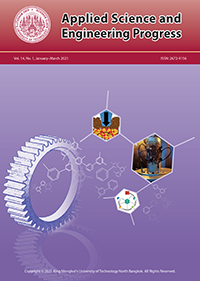Evaluation of Forging Die Defect by Considering Plastic Deformation and Abrasive Wear in a Hot Forged Axle Shaft
Main Article Content
Abstract
In the hot forging process, an abrasive wear is a major problem in the manufacturing process which may possibly happen together with the plastic deformation. Both effects are difficult to distinguish in the real tooling. Finite Element Modeling (FEM) is a tool that use to simulate those phenomena in the hot forging process. However, some unknown factors are not directly obtained from the actual measurement. Thus, the sensitivity analysis is applied together with FEM to approximate those parameters. This research was to evaluate the die defects of the hot forged axle shaft process which were the plastic deformation and the abrasive wear. The reliable simulation modeling was developed by conducting the sensitivity analysis of the unknown parameters; heat transfer and friction coefficient, and compared the results with the experimental results. Then, the evaluation of the defects was performed by considering the effect of the plastic deformation and abrasive wear separately. The plastic deformation would be determined by comparing the effective stress with the yield strength of the die material at the same temperature. To predict abrasive wear in 3D space the die profile from the actual process was measured by CMM and then it was compared with that obtained by FEM. Archard’s model was used to predict the abrasive die wear in FEM. The variation of the K-values was significant to the wear prediction. According to this study, the average K-value obtained from different positions gives the best representative than considering only a single point K-value.
Article Details
References
[2] K. Lange, L. Cser, M. Geiger, and J. A. G. Kals, “Tool life and tool quality in bulk metal forming,” CIRP Annals, vol. 41, no. 2, pp. 667–675, 1992.
[3] M. Shirgaokar, “Technology to improve competitiveness in warm and hot forging: Increasing die life and material utilization,” Ph.D. dissertation, The Ohio State University, 2008.
[4] S. Babu, D. Ribeiro, and R. Shivpuri, “Material and surface engineering for precision forging dies,” The Ohio State University, 1999.
[5] S. Chander and V. Chawla, “Failure of hot forging dies – An updated perspective,” Materials Today: Proceedings, vol. 4, no. 2, pp. 1147–1157, 2017.
[6] C. Choi, A. Groseclose, and T. Altan, “Estimation of plastic deformation and abrasive wear in warm forging dies,” Journal of Materials Processing Technology, vol. 212, no. 8, pp. 1742–1752, 2012.
[7] I. Kova, B. Szewczyková, P. Blaškovitš, E. Hodúlová, and E. Lechovi, “Study and characteristic of abrasive wear mechanisms,” MTF STU, Tranava, Slovakia, 2009.
[8] T. Altan, G. Ngaile, and G. Shen, Cold and Hot Forging: Fundamentals and Applications. Ohio: ASM International, 2004.
[9] M. Deshpande, “Improvements in hot forging process- using alternative die materials and finite element analysis for wear prediction and die design optimization,” The Ohio State University, 2011.
[10] J. L. G. Méndez, “Prediction of die wear in warm forging process with forward extrusion operations,” M.S. thesis, Instituto Tecnológico y de Estudios Superiores de Monterrey, Mexico, 2008. [11] A. Groseclose, C. Choi, and J. L. Gonzalez- Mendez, “Estimation of die stresses and wear in warm forging of steel pinion shafts,” Ohio, USA, Rep. ERC/NSM-08-R-34, 2009.
[12] J. F. Archard, “Contact and rubbing of flat surfaces,” Journal of Applied Physics, vol. 24, no. 8, pp. 981–988, 1953.
[13] DEFORM Version 11.0.2 User’s Manual, Scientific Forming Technologies Corporation, Ohio, USA, 2018.
[14] R. S. Lee and J. L. Jou, “Application of numerical simulation for wear analysis of warm forging die,” Journal of Materials Processing Technology, vol. 140, no. 1–3, pp. 43–48, 2003.
[15] H. Qvarnström, “Technical note: A mathematical formula for transformation between the steel hardness scales of Rockwell C and Vickers,” Journal of Heat Treating, vol. 7, no. 1, pp. 65–67, 1989.
[16] E. J. Pavlina and C. J. Van Tyne, “Correlation of yield strength and tensile strength with hardness for steels,” Journal of Materials Engineering and Performance, vol. 17, no. 6, pp. 888–893, 2008.


